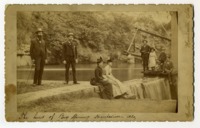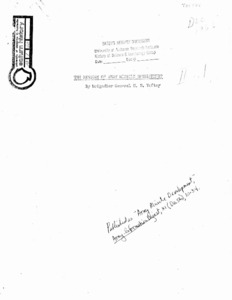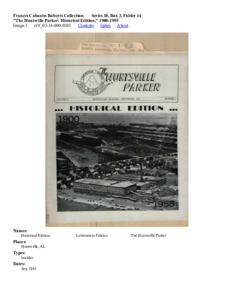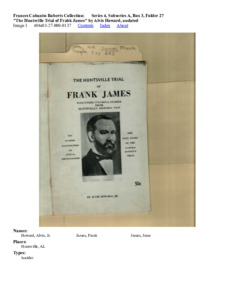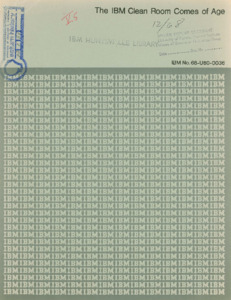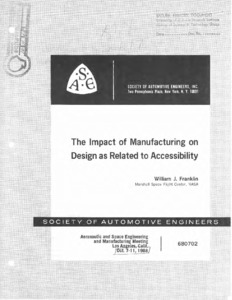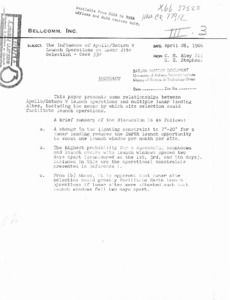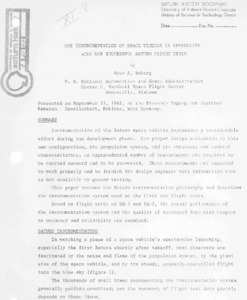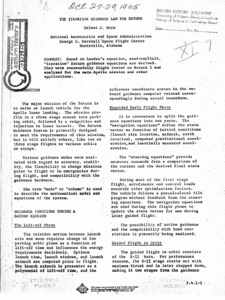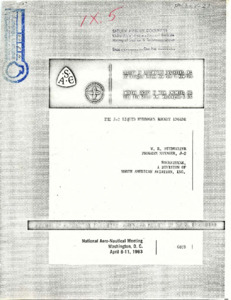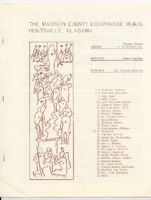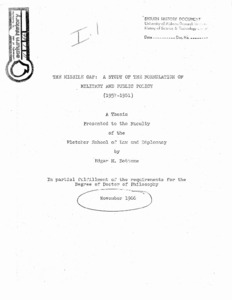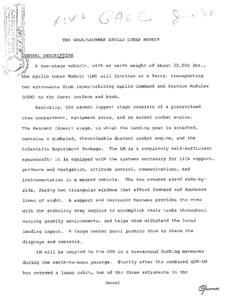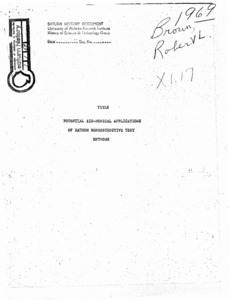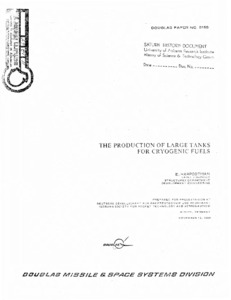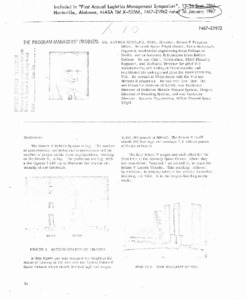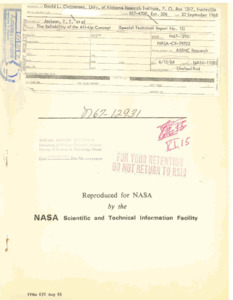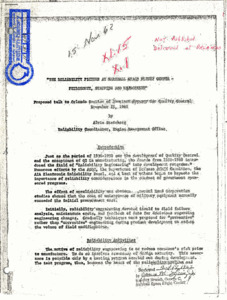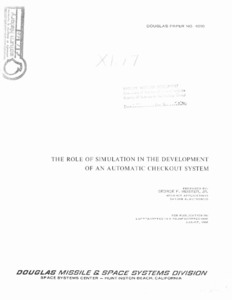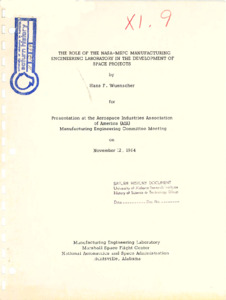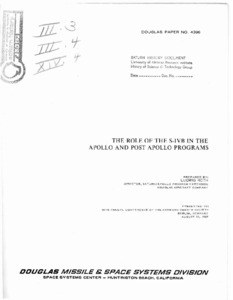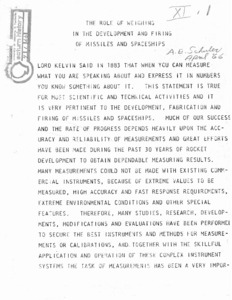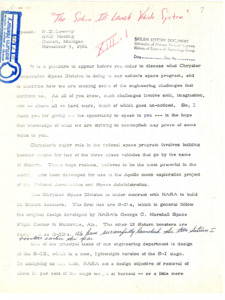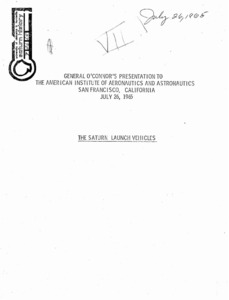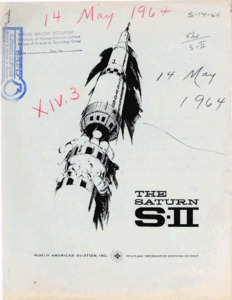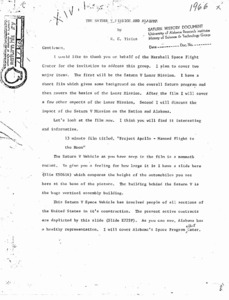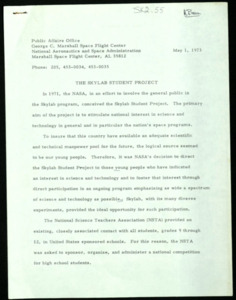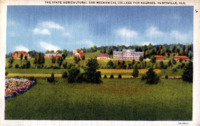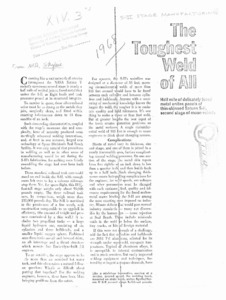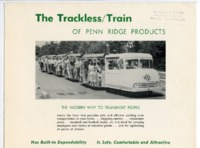
Browse Items (7888 total)
Sort by:
-
"The Forecast...AIDS is threatening on all fronts. Protect yourself from the storm."
A man and woman's shoes on the floor with rain on the floor and the shoes -
"The history of Army missile development."
Published as "Army Missile Development," Army Information Digest, XI. Establishes the development and history of weaponized rocket ordenance. -
"The IBM Clean Room Comes of Age."
A history of the IBM's Space Systems Center clean room and a description of its uses. -
"The impact of manufacturing on design as related to accessibility."
The purpose of this paper is to emphasize the need for accessibility in the assembly and maintenance of spacecraft. This is especially pertinent because accessibility to subsystems for replacement, repair, and maintenance has proven to be one of the more costly phases of preflight preparation. The most successful programs in this day and age have been when the design and manufacturing engineers work side by side around a mockup where solutions to the problems can be visually seen and solved, keeping in mind the assembly as related to accessibility. Therefore, it will be shown that in order to overcome the difficulties, designers should adapt a hard, fast ground rule that each unit must be accessible and individually removable without disturbing the other units.; Aeronautic and Space Engineering and Manufacturing Meeting, Los Angeles, Calif. Oct. 7 - 11, 1968. -
"The Influence of Apollo/Saturn V Launch Operations on Lunar Site Selection: Case 330."
This paper presents some relationships between Apollo/Saturn V launch operations and multiple lunar landing sites, including the means by which site selection could facilitate launch operations. -
"The instrumentation of space vehicle in connection with the successful Saturn flight tests."
Presented on September 21, 1962, at the Eleventh Tagung Der Deutchen Raketen - Gesellschaft, Koblenz, West Germany. Instrumentation sf the Saturn space vehicle represents a considerable effort during the development phase, for proper design evaluatian of this new configuration, its propulsion system, and its structure and control characteristics, an unprecedented number of measurements are required to be carried onboard and to be recovered, These measurements are expected to work properly and to furnish the design engineer with information that is not available by ground testing, -
"The Iterative Guidance Law for Saturn."
Summary: "Based on Lawden's equation, semi-explicit,'iterative' Saturn guidance equations are derived, many were successfully flight tested on Saturn I and analyzed for the main Apollo mission and other applications applications." -
"The J-2 Liquid Hydrogen Rocket Engine."
The 5-2 high-energy liquid propellant rocket engine (~i~. l), a large engine producing 200,000 pounds of thrust at altitude conditions, burns liquid hydrogen and liquid oxygen to produce the necessary high specific impulse for practical space use. Rocketdyne, a Division of North American Aviation, Inc., is developing the engine for the George C. Marshall Space Flight Center, Xfi. The first use of the engine will be in the upper stages of the Saturn vehicles. Five engines will be used for the second, S-I1 stage of the Saturn V, and one will power the S-IVB third stage of the Saturn V and S-ISTI second stage of 'the Saturn IB; Original is a photocopy on onion skin. -
"The Madison County Courthouse Mural, Huntsville, Alabama."
Reprinted as part of the Alabama sesquicentennial celebration, this pamphlet was originally produced for the dedicated of the new Madison County Courthouse in 1967. Includes an order form for a special sesquicentennial edition of Valley Leaves. -
"The Military Outstanding Volunteer Service Medal; Sometimes it's harder to secure a neighborhood at home than a beachhead abroad. Make a difference; Volunteer!"
Pictures of military volunteering in their communities and a quote from Gen. Colin L. Powell -
"The Missile gap : a study of the formulation of military and public policy."
A thesis presented to the faculty of the Fletcher School of Law and Diplomacy. In partial fulfillment of the requirements for the Degree of Doctor of Philosophy.; This document is only the abstract of the thesis.; Document includes biographical note and table of contents.; aArchive copy is a photocopy. -
"The Mourning After; Don't Drink and Drive"
People mourning someone at a funeral after that person decided to drink and drive -
"The NASA/Grumman Apollo lunar module"
Handwritten in pencil on the document. Describes the layout and function of various sections of the Apollo lunar module. -
"The New Huntsville Campus."
The leaflet provides "Facts About The University of Alabama's New Huntsville Campus" including general information, student enrollments, and projected growth. -
"The potential bio-medical applications of Saturn nondestructive test methods."
A brief history and purpose of nondestructive methods followed by a discussion of those methods. -
"The price of freedom...A strong defense"
Soldiers at war with American flag in the background -
"The Price of Freedom...A Strong Defense"
Soldiers at war with American flag in the background -
"The production of large tanks for cryogenic fuels"
Archive copy is a poor photocopy. Prepared for presentation at Deutsche Gesellschaft fur Raketentechnik und Raumfahrt. (German Society for Rocket Technology and Astronautics). Given by E. Harpoothian, Chief Engineer, Structures Department, Development Engineering.; Tanks for cryogenic fluids, as used in the Saturn space vehicles, have reached an advanced stage of design and development. Many of the structural features of the NASA/Douglas Saturn tanks, fabricated of 2014-T6 aluminum alloy, were first developed for the booster of the Thor ballistic missile, which later found extensive use in putting space vehicles into orbit. There is a mutual dependence of important factors related to design concepts, selection of materials, processing techniques, and fabrication methods. It is shown that this mutual dependence must be considered if a successful vehicle is to emerge from design and development. Details of vehicle structure, provision for insulation, and manufacturing methods are presented. Criteria for the selection of materials is shown to be dependent on strength, ductility, weldability, toughness, fabricability, behavior at cryogenic temperatures, and on manufacturing methods and inspection techniques. -
"The program manager's problem"
Included in "First Annual Logistics Management Symposium," Huntsville, Alabama; Archive copy is a poor photocopy. Describes the stages of rocket-development/launch and the logistical problems with each. -
"The reliability of the all-up concept."
Prepared for George C. Marshall Space Flight Center, Huntsville, Alabama under contract NAS8-11087. Publication No. 294-02-12-440. Special Technical Report No. 13.; INTRODUCTION: The Saturn/Apollo Systems Office at the George C. Marshall Space Flight Center (MSFC) requested ARINC Research Corporation to make a brief study of the reliability aspects of the All-Up concept. Under the requirements of Task 294-02 of Contract NAS8-11087, the study included a comparison between the reliability of the first Saturn V vehicle if All-Up, and its reliability with dummy upper stages. -
"The reliability picture at Marshall Space Flight Center - philosophy, staffing and management. Proposed talk to Orlando Section American Society for Quality Control."
Document that discusses the importance of reliability in engineering. -
"The role of simulation in the development of an automatic checkout system"
For publication in Luftfahrttechnik Raumfahrttechnik. Discusses the uses and advantages to using simulations. -
"The role of the NASA-MSFC Manufacturing Engineering Laboratory in the development of space projects."
For presentation at the Aerospace Industries Association of America (AIA) Manufacturing Engineering Committee Meeting. Discusses the role the NASA Engineering Laboratory has had on NASA projects in the form of vehicles and smaller projects. -
"The role of the S-IVB in the Apollo and past Apollo programs."
Douglas Paper No. 4396.; Prepared by Ludwig Roth, Director, Saturn/Apollo Program Extension, Douglas Aircraft Company.; Presented to 16th Annual Conference of the Hermann Oberth Society. Discusses the role of the Apollo rocket after the Apollo program has concluded. -
"The role of weighing in the development and firing of missile and spaceships."
Speech regarding the importance of developing and upgrading space ships and space technology. -
"The Saturn IB launch vehicle system."
Speech containing information regarding Crystler's role in the Saturn Project as contracted builders of the stages of three space vehicles. -
"The Saturn launch vehicle family."
Presentation focusing on the history of Saturn V's engineering history and crew. -
"The Saturn launch vehicles."
General O'Connor's presentation to the American Institute of Aeronautics and Astronautics. Centers around saturn space vehicles and makes references to slides. -
"The Saturn S-II."
The S-II is the second stage of NASA's Apollo moon-landing rocket - the giant Saturn V. The most powerful hydrogen-fueled booster under production, the S-II is destined for Apollo manned lunar missions and will help power three Americans to the moon. The S-II is being developed and manufactured at Seal Beach, Calif., by North American's Space and Information Systems Division, Downey, Calif., under the technical direction of NASA's Marshall Space Flight Center, Huntsville, Ala. -
"The Saturn V mission and Alabama."
Speech that covers the topics of the Saturn V lunar mission and the basics of a lunar mission in general. -
"The Season's Greetings."
This greeting card was sent from M. Louis Salmon in Vienna, Austria to his parents in Mobile, Alabama at Christmas 1945. The inscription reads, "Your devoted son, Louis." -
"The significance of parameters affecting the heat transfer to the liquid hydrogen in the Saturn S-IVB stage for the lunar orbit rendezvous mission."
The Saturn S-IVB stage has a requirement for orbiting around the earth for up to 4.5 hours with approximately 60 percent of its initial propellant remaining at the end of the coast (prior to restart) . Extensive analyses must be performed to insure that this requirement is met. Both the maximum and minimum heat transfer rates are important because the maximum rates affect the hydrogen boiloff losses and thus the initial propellant loading requirements. The minimum rates are important because the boil off gases are used to maintain a minimum axial thrust level by venting the gases continuously through aft facing nozzles. This provides for a settling of the propellant throughout the orbital coast and alleviates the need for periodically venting the tank under zero gravity. -
"The Skylab Student Project."
Students involved in the student experiment selection are: Bochsler, Daniel C., Converse, Vincent W., Crites, Troy A., Dunlap, W. Brian, Hamilton, John C., Hopfield, Alison, Jackson, Kathy L., Johnston, Roger G., Leventhal, Jeanne L., Meister, Todd A., Miles, Judith S., Peltz, Cheryl A., Quist, Terry C., Reihs, Joe W., Schlack, Donald W., Wordekemper, Joel G., Shannon, Neal W., Staehle, Robert L., Zmolek, Joe B. Students whose experiments were held in consideration for future programs are Stein, Keith L., Brandt, Kent M., McGee, Keith, Sherhart, Kirk M., Merkel, Gregory A., Healy, James E. -
"The State Agricultural and Mechanical College for Negroes"
Front: The State Agricultural and Mechanical College for Negroes, Huntsville, Ala. -
"The Tetons - Yellowstone Park - Mud Volcano - Dragon's Mouth."
Konrad, Ingeborg, and Klaus Dannenberg see Teton National Park and Yellowstone National Park. In Yellowstone, Konrad captured footage of the "mud volcano" and the "dragon's mouth" as well as some local wildlife. Summer 1956. -
"The toughest weld of all" S-II stage manufacturing.
Article explores the outer layer of the Saturn S-II along side its benefits and complications. Contains poorly rendered images displaying the process. -
"The Trackless/Train-Of Penn Ridge Products."
This leaflet contains photographs, descriptions, and specifications of the Trackless/Train.

